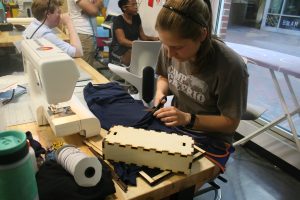About Makerspace
![]()
At Carolina, the Makerspace program focuses on the design and making of physical objects as a way to learn research and entrepreneurship. The program aims to: (1) support the integration of making into new and existing courses via faculty course development grants, faculty learning communities, teaching awards, and training for faculty and teaching assistants; (2) establish one-credit skills courses that students can use to demonstrate deep knowledge of specific techniques; (3) support campus-wide maker events and expand BeAM (Be A Maker) into the residence halls; and (4) establish workshops that train students in the maker skills needed to launch them directly into research groups.
We are developing a diversity of Makerspace classes across campus. See our course listings.
“One of my favorite classes so far was the day we had an interesting discussion about applying the physics concepts we had been learning to the Escapement project. Before this class, I didn’t totally understand the purpose behind the project (other than it sounded interesting), but after this class discussion I was able to see how this project actually helped us learn the material better. The escapement operating in front of us inspired great questions and an interesting discussion.”
 Students are empowered to apply creativity and innovation in all of their academic, research, and co-curricular pursuits, forging natural connections between the arts and humanities and the sciences. A broad goal of all QEP programs is for students to learn about failure, iteration, and resilience. Makerspace courses have a unique opportunity to give students the time to experience and grow in these ways. Students who complete a Makerspace course will be able to: (1) apply a design-thinking and/or iterative processes to developing ideas related to course concepts; (2) articulate specific ways experiential learning through Making has enhanced their understanding of course concepts; (3) produce work that shows evidence of of innovation, risk-taking, collaboration, a design process, fabrication, documentation, and communication of process; and (4) effectively critique others’ work and use critiques of their own work for improvement. Students are required to attend an orientation in the Makerspace and register for training session to utilize the specialize equipment. A list of the Makerspace tools and capabilities is located on the BeAM webpage.
Students are empowered to apply creativity and innovation in all of their academic, research, and co-curricular pursuits, forging natural connections between the arts and humanities and the sciences. A broad goal of all QEP programs is for students to learn about failure, iteration, and resilience. Makerspace courses have a unique opportunity to give students the time to experience and grow in these ways. Students who complete a Makerspace course will be able to: (1) apply a design-thinking and/or iterative processes to developing ideas related to course concepts; (2) articulate specific ways experiential learning through Making has enhanced their understanding of course concepts; (3) produce work that shows evidence of of innovation, risk-taking, collaboration, a design process, fabrication, documentation, and communication of process; and (4) effectively critique others’ work and use critiques of their own work for improvement. Students are required to attend an orientation in the Makerspace and register for training session to utilize the specialize equipment. A list of the Makerspace tools and capabilities is located on the BeAM webpage.
“Students were surprised that they could do this! Many of them felt a sense of accomplishment when the realized that they could master something like 3-D printing or designing something to take to the laser cutter.” –Makerspace FLC member
Faculty are passionate about teaching Makerspace courses than a more traditional course.
WHAT ARE THE ESSENTIAL CHARACTERISTICS OF BEING A MAKER?
Collaborate
Being part of the growing maker movement on campus, you will make new friends from different backgrounds and disciplines. Does your project need expertise you are lacking? Chances are excellent that there will be another maker who will be happy to help, share, and teach you new skills.
Create
You will be part of a vibrant community of makers as you tinker, design and build in highly collaborative environments that provide the tools, training and support you need to turn ideas into real objects.
Research
Whether you are a student, staff member or faculty building instruments or artwork for your scholarly activities, or an entrepreneur prototyping a concept, at BeAM you can make your ideas real.
Learn
You have many free workshops to choose from, and will enjoy on-site support in 3D printing, laser cutting and electronics, as well as woodworking and metalworking. If you are a faculty member, you will have our support in integrating making into your classroom.
Check out the Be A Maker website for additional information and to find the Makerspace facilities on campus.
WANT MORE?
Arts & Sciences magazine article about Meet the Maker.
Arts & Sciences magazine article about BeAM Learning and Innovation Studio provides space for long-term projects.
Arts & Sciences magazine article about A Natural Fit.
Read On the Job Training article in the University Gazette.
Arts & Sciences magazine article about a new course combining thinking and experiential making.
Read Making Scientist in the University Gazette.
Reimagining science education for visually impaired students
Students create telescope in BeAM workshop
Creating a community of makers (about Murray Makerspace)
